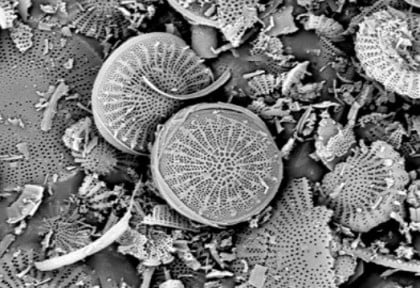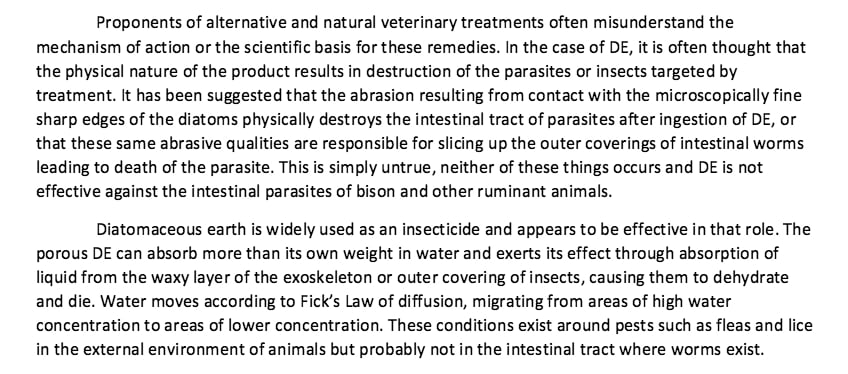
Following on from my post, Worming Horses Naturally – Is It Possible?, I received even more questions and links to anecdotal blog posts about the use of diatomaceous earth (DE) as a natural anti-helmintic treatment for horses.
Blog posts like this one from Joe Camp seemed to directly contradict my quote from equine parisitologist, Dr. Martin K. Nielsen, that clinical trials done with diatomaceous earth showed no significant reduction in worm burden.
So of course, I then had to go looking for Dr. Nielsen’s sources – which took me about four hours! – to try to ascertain WHY the clinical studies on DE showed no reduction in Fecal Egg Counts (FEC), but yet horse owners like Joe Camp were claiming an FEC reduction after using diatomaceous earth.
DE Dosage Too Low?
Personally, I wondered if the reason the clinical trials for DE didn’t work was because they were using too small a dosage? Also, in Camp’s post, he points out that the type of DE you use is also important as different brands have double the surface area and a higher pore volume than others.
Well, as someone who’s used DE successfully in various topical applications, I’m sad to say that despite all the anecdotal evidence to the contrary, in all of the clinical studies I looked at, DE did not have an significant effect on worm burdens in steer, sheep, or goats.
One of the studies even gave the specs of the diatomaceous earth they used – similar to Joe Camp.
And here’s the kicker: The clinical trials using diatomaceous earth used a higher dosage of DE than Joe Camp and many other laypeople! So there goes my theory about the dosage being too low. 🙁
The standard diatomaceous earth dosage in clinical trials (in the 4 I looked at) seems to be 2% of DMI (dry matter intake) per day.
The average DM intake for a 1000 lb horse is 20 lbs per day, which equals 8 kg, so 2% would be 160 g (2.5 cups) of diatomaceous earth per day.
Joe Camp reports a reduction in fecal egg count feeding a maximum dosage of 2 cups DE per day for 14 days. But that’s only 128 g per day, which is less than the dosage used in the clinical trials!
Why Do Some Report Success De-Worming with Diatomaceous Earth?
So WHY might Camp’s horses have a reduced FEC (assuming he is carrying out the FEC test correctly)? Well, as Dr. Nielsen stresses repeatedly, pasture management is absolutely key in reducing the worm burden in your horses. Lots more info on pasture/manure management here. So perhaps Camp is very good at removing manure promptly, or using high sun exposure of sufficient duration to harrow and kill worms, or composting before spreading manure back on cleared fields.
Another point that emerges when you study the clinical trials is that even in the control groups (given nothing) the FEC reduces or peaks according to the season – or perhaps even the weather, or soil conditions – more study is definitely needed on both the environmental conditions that affect worm burdens and on the ability of the animal’s own immune system to take care of challengers.
It basically comes down to this: Without a control group (untreated horses kept in exactly the same conditions) you just cannot know whether the change in FEC is due to anything you’ve administered, or would have naturally occurred anyway.
The good news – for those of us who will continue to search for natural de-worming methods that work reliably (other than pasture management) is that ongoing research into herbal and other natural methods of parasite control is ongoing.
Currently, Dr. Nielsen is fundraising for a study on a strain of Bacillus thuringiensis (soil bacteria) that has thus far proven 97% effective in pig trials. You can learn more about that here, Let the Germs Get the Worms (p.s. the Donate button is not in the videos, it is at the top right of the page).
HOW Does Diatomaceous Earth Work Anyway?
And one last point before I close – because this seems to be a point of misunderstanding, even in some of the scientific literature. Some think that DE works because the crystalline silica ‘spikes’ on the diatom skeletens pierce the worms or parasites. However, this is not correct and superior forms of DE are actually certified to contain mostly ‘non-harmful’ amorphous silica.
The mechanism that is believed to kill worms and parasites is the dehydrating effect – where the DE pulls body fluids out of the worm’s bodies thereby killing them. However, as you might imagine, there is a lot of water/moisture inside the gut of any living creature. So how can we expect this dehydrating mechanism to work well in that kind of environment?
Murray Woodbury DVM, MSc sums this up nicely in his article, The Real Dirt on Diatomaceous Earth Used For Worming Bison:
 However, as you may have experienced, this is precisely why diatomaceous earth works so well externally on pets, gardens, and even clearing your kid’s super oily hair after a natural lice treatment!
However, as you may have experienced, this is precisely why diatomaceous earth works so well externally on pets, gardens, and even clearing your kid’s super oily hair after a natural lice treatment!
Sources:
And one last ‘behind the scenes’ comment from Dr. Martin Nielsen regarding these studies:

“In addition to these published reports, there are several additional unpublished studies. Some have been presented at conferences and others have just been communicated to me by colleagues. All showing the same thing. Several of my colleagues have attempted to set up coprocultures, where parasite eggs are hatched and larvae emerge. They all found that presence of DE at various dosages in these cultures did not appear to affect larval survival.”
Fernandez MI., Woodward BW. and Stromberg BE. 1998. Effect of diatomaceous earth as an anthelmintic treatment on internal parasites and feedlot performance of beef steers. Animal Science 66:635-641
“Offering 20 g DE per kg food intake for 46 days to beef steers on a high cereal-based diet had no effect”
McLean, Barbara et al. THE INCLUSION OF DIATOMACEOUS EARTH IN THE DIET OF GRAZING RUMINANTS AND ITS EFFECT ON GASTROINTESTINAL PARASITE BURDENS, ADAS, UK
Again, look at the Tables provided to see the peaks and troughs in FEC across all 3 groups tested (chemical wormer group, control group and DE group).
Allen, Janet. Organic Farming Research Foundation Project Report #98-03: Alternative Parasitides for Organic Lamb Production
“Overall, no pattern or improvement can be seen in any one of the samples from the different testings. In
fact, the Control group, Group 1, received no treatment at all for worms and ended up with the lowest count overall
for this particular type of parasite.”
Ahmed M., Laing MD and Nsahlai IV. 2013. Studies on the ability of two isolates of Bacillus thuringiensis, an isolate of Clonostachys rosea f. rosea, and a diatomaceous earth product, to control gastrointestinal nematodes of sheep. Biocontrol Science and Technology
“DE was fed at 2% of sheep diet. Relative to the control, treatments had no effect (P>0.05) on EPG, but reduced (P<0.001) larvae per gram (LPG) in faecal culture. Efficacy varied with time (P<0.001). On Day 7, Bacillus thuringiensis Berliner (Bt), Clonostachys
rosea f. rosea Schroers (C. rosea) and diatomaceous earth (DE) had efficacies of 76, 87 and 61%, respectively.”
*The interesting thing about this study is that although the diatomaceous earth had no effect on parasites, the combination of the B. thuringiensis and the C. rosea together showed the highest efficacy at reducing FEC.
Share The Love
If you’ve had success (ideally documented, using Fecal Egg Count testing, please) with a natural de-wormer, please let us know what you did in the Comments section below. And very important: Please include details on dosage and how many times a day you administered the substance.
Also tell us what you’re doing with your manure and pastures to reduce or manage the re-infestation and contamination issues of worm control. Oh yes, and be sure to mention which climate or town you live in – since weather conditions greatly affect worm control practices. Let’s pool our resources and ideas because you never know when someone might have a little tweak that makes all the difference!

Jini Patel Thompson is a natural health writer and Lazer Tapping instructor. She began riding at age 2 in Kenya, and got her first horse at age 8 in Alberta, and so continues a life-long journey and love affair with these amazing creatures.








Thank goodness you are doing some of the heavy legwork to find, consolidate and present this information. If I can ever finish our first project I have a research project/trial I’m doing with conventional sand purge type products that I’d love for you to share in your blog.
We’re both in it for the long-term Sarah – we’ve got lots of time to get all the goodies out there! Onward and upward!
Pingback: Diatomaceous Earth - The Horse Forum
Hi Jini, I came across this from Clemson Univ and wondered if you had seen it. Showed success in DE for cattle in reducing FECs compared to control, three groups in all.
Liink: http://www.fertrell.com/2012_mar_apr.pdf
Scroll down to page 10.
Alternative Anthelmintics for
Organic Dairy Cattle
Project Leader: Dr. Jean Bertrand, Professor, Animal
and Veterinary Science
117 Poole Ag. Center, Clemson University, Clemson,
SC 29634-0311
Thank you for your thoughtful page, looking forward to seeing more of it.
Carol Walters
No, I had not seen that! Thanks so much for sharing, I will check it out…
Carol I finally had a chance to go through the study. I find it interesting that a reduction in FEC did not show up until 6 weeks – after bi-weekly administration of the DE wormer for 3 weeks in a row.
I also wonder whether this is an independent study from Clemson University, or a paid trial; paid for by the manufacturer(s) of the natural wormers. Obviously that plays a role in the validity of the study…
The DE wormer they used in trial also contained Cayenne and Garlic – both very potent substances, so let’s just say the study was reliable, then perhaps it is the addition of these two substances (or the synergy) that has produced the result. It certainly would be worth trying – here is the Fertrell wormer used in the study:
http://fertrell.com/fertrellherbalpaste.htm
The pic I uploaded here is from a presentation to the Southern Goat Producers Association by Dr. Pugh. These are all academic studies that show good promise for other natural substances. Wouldn’t it be great if Fertrell added 3 of these substances to their wormer (at the weight-specific dosage indicated) as well! Of course, they would need to test efficacy in horses first 🙂
Lastly, here’s another article with some useful info as well, and a reminder that manure management is critical:
http://www.veterinarypracticenews.com/13-guidelines-to-follow-when-deworming-horses/
Thanks for sharing this. I had not heard of using DE before as a dewormer. I was using the ivermectin.
It’s good to learn of more natural methods. I’ll have to talk to my vet next week about this when I visit. I have a 3 year old mare that I recently acquired.
Hello
Good Day
Thank you for useful article regarding diatomaceous earth. Please keep us updated with more useful information.
Best Regards
Mazyar
If it takes that much per day to clean out a horse, how much would it take for humans, @150 lbs, especially if there is a heavy parasite/worm infestation? Thanks!
Do an internet search Mary – there is LOTS of info on using DE for humans. I personally don’t have any experience with it. This is the protocol I’ve used:
https://listentoyourgut.com/an-intestinal-parasite/
I used diatomaceous earth for my puppy who had coccidia. She was very sick with loose stinky stools and in one month I took her stool sample in and it was clear. They wanted to put her on antibiotics and I refused. I’m glad I did this cleared it up in a week!
Awesome! Thanks so much for sharing your experience. Did you mix it in her food? And how much did you give her per day?
I keep seeing posts that DE is not a natural wormer BUT I fed on cup of it to each of the same 14 horses that I had here in my barn for over 3 years and we did worm checks ever 6 months and NEVER HAD ANYTHING BUT A ZERO WORM COUNT, even though some of the horses had worms when they first arrived!! I used the DE for over 35 years and never had an issue with sick horses from chemical wormers or any issues with worm infestation on the properties!! PLUS we spread the DE on the manure pile on a regular basis and that REALLY helped to cut down on the amount of flies!! Loved the stuff!!
That’s awesome! Thanks so much for sharing your experience. Did you feed 1 cup per day, every day, 365 days/year? Or? Love to hear the details…
Yes, I fed one cup of the DE every day without missing any!! In the original research that I did, AND I do have a habit of NOT listening to the doctors say, and doing my own research to all of the older than me, and those were the “Older than dirt” then horse people who had used DE for years and years with never an issue and never a worm build up. (And that was back in the 1980’s and now I am the older than dirt one!!) AND ALSO, they talked about feed a cup of it each day, because of all the other things that it took care of. I could never find the list of “all the other things” but decided if it helped back before there were chemical wormers on the old western ranches, then I too would try it that way and I never had any complaints, and nor did any of the horse’s owners!! Just the opposite!! Their horses coats were shiny and gorgeous, and the horses were all happy and easy to deal with, and properly spoiled!!
Thank you Barbara! This is very helpful information. A cup a day sounds like a lot – and it would be for a human, but for a horse… I think that’s .001% of body weight? Did you mix it with anything, or feed it straight?
I fed it mixed with my feed, which was NOT sweet feed. It was a recipe made up for me by my Vet. and worked very well for all of my horses… and their evening feed was like a hot mash, since we mixed the feed with hot water so that the DE was NEVER fed dry, which could have caused other issues!! AND again, it was because of the other help that it seemed to give all of the horses, I always continued to feed one cup to each horse!! We became known for some of the shiniest horses at a boarding barn ever!!